InterviewSolution
This section includes InterviewSolutions, each offering curated multiple-choice questions to sharpen your knowledge and support exam preparation. Choose a topic below to get started.
| 3651. |
Question : Discuss briefly the different types of reproduction. |
|
Answer» SOLUTION :Living organisms reproduce mainly by two methods : (1) Asexual reproduction : In this mode of reproduction, the OFFSPRING arises from a single individual parent. Asexual type of reproduction takes place in unicellular organisms, some PLANTS, and certain multicellular animals like sponges and Hydra. Main types of asexual reproduction are : (i) Fission (ii) Budding (iii) Spore formation. (iv) Regeneration. (v) VEGETATIVE propagation. (2) Sexual reproduction : For sexual reproduction, involvement of the two sexes, male and female, is essential. Sexual reproduction involves union of sperm (male gamete) and egg (female gamete). These gametes are produced by gonads testis in males and ovary in females. |
|
| 3652. |
Question : Disaster and its management |
|
Answer» Solution :(i) Various dangerous events occur many times in the environment. These are called disasters. (ii) These are .all of a sudden. troubles to the mankind. Such events cause sudden changes in the environment and thereby, cause damage to it. (iii) Disaster is a sudden event that leads to huge loss of life and property. (iv) Disastermanagement is either prevention of disasters or making arrangements to face them or at least achieve the abilities to face them. (v) Disasters are never planned but losses DUE to them can beprevented in a planned manner. (vi) Disaster management is achiving or time to time improving the ability to face the disaster through scientific and careful observations and analysis of data. (vii) For example, preparing the action PLAN through study of various aspects LIKE PREVENTATIVE measures,rehabilition and reconstruction and executing that plan is management of disaster. (viii) Increasing awareness about disaster management among the GENERAL public through training programs, mass media etc. will enable them to be always prepared for disaster rescue. |
|
| 3653. |
Question : Dinosaurs were abundant in |
|
Answer» Jurassic |
|
| 3654. |
Question : Digestion within a digestive tract is |
|
Answer» incomplete |
|
| 3655. |
Question : Digestion of fats in man occurs maximum in? |
|
Answer» BUCCAL cavity |
|
| 3656. |
Question : Digestion is |
|
Answer» CONVERSION of LARGE food particles into SMALL food particles |
|
| 3657. |
Question : Digestion of a leech takes place in the stomach by ________ enzyme. |
| Answer» SOLUTION :PROTEOLYTIC | |
| 3658. |
Question : Digestion in Hydra is |
|
Answer» INTRACELLULAR |
|
| 3659. |
Question : Digestion in a Hydra takes place within its |
|
Answer» mouth |
|
| 3660. |
Question : Differentiate the word pair : Uterus and urethra |
|
Answer» SOLUTION :Uterus is an ELASTIC bag like STRUCTURE in female REPRODUCTIVE system where embryo is IMPLANTED and nourished. Urethra is a common passage for passing sperms and urine in males. |
|
| 3661. |
Question :Differentiate the following (a) Monocot root and Dicot root (b) Aerobic and Anaerobic respiration |
Answer» SOLUTION :
|
|
| 3662. |
Question : Differentiate homologous organs and analogous organs. |
Answer» SOLUTION :DIFFERENCES between HOMOLOGOUS ORGANS and ANALOGOUS organs : 
|
|
| 3663. |
Question : Differentiate between xylem and phloem . |
Answer» SOLUTION :
|
|
| 3664. |
Question : (a) Write a note on Triticale. (b) Differentiate between Type-1 and Type-2 diabetes mellitus. |
Answer» SOLUTION :
|
|
| 3665. |
Question : Differentiate between the following : (i) Pollen tube and style. (ii) Fission in Amoeba and Plasmodium (iii) Fragmentation and Regeneration (iv) Bud of Hydra and bud of Bryophyllum |
Answer» SOLUTION :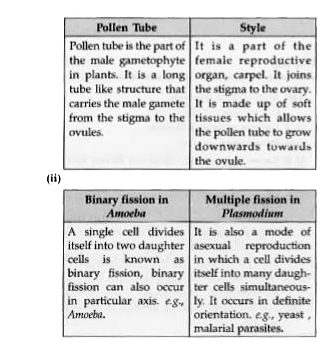 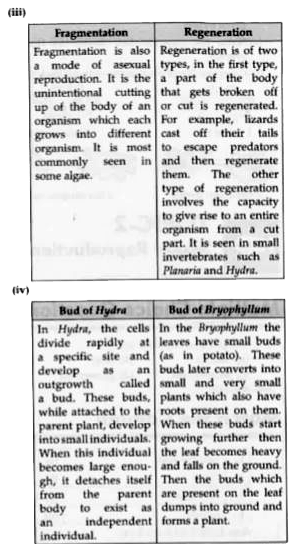
|
|
| 3666. |
Question : Differentiate between the electron microscopic structure of cilia/flagella and centrole. |
Answer» SOLUTION :
|
|
| 3667. |
Question : differentiatebetweenststoneand diastoleexplainthe conductionof heartbest . |
|
Answer» Solution :One complete contraction (SYSTOLE) and relaxation (diastole) of the atrium and ventricles of the heart constitutes Heartbeat. The human heart is myogenic. Contraction is initiated by sino-atrial (SA) node, which is situated in the WALL of the right atrium, near the opening of the superior vena cava. SA node is broader at the top and tapering below and MADE up of thin FIBRES SA node acts as the ‘pacemaker. of the heart because it is CAPABLE of initiating impulse which can stimulate the heart muscles to contract. The impulse spreads as a wave of contraction over the right and left atrial wall, pushing the blood, through the atrioventricular valves into the ventricles and the same wave from SA node reaches the atrioventricular node (AV), to emit an impulse of contraction, spreading to the ventricular muscle, through the atrioventricular bundle and the Purkinje fibres. The expansion of the artery every time, the blood is forced into the arteries, is called pulse. Normal pulse rate ranges from 70 - 90 / min. |
|
| 3668. |
Question : Differntiatebetweensystemiccirculationnand pulmonarycirculation ? |
Answer» SOLUTION :
|
|
| 3669. |
Question :Differentiate between self-pollination and cross-pollination. |
Answer» SOLUTION :
|
|
| 3670. |
Question : Differentiate between reproduction and regeneration. Name any two organisms that grow by regeneration. |
Answer» SOLUTION : TWO ORGANISMS that grow by REGENERATION are Hydra, Planaria. |
|
| 3671. |
Question : Differentiate between outbreeding and inbreeding. |
|
Answer» Solution : Differentiate between outbreeding and inbreeding, Inbreeding: When BREEDING or MATING takes place between animals of the same breed, for about 4-6 generations, then it is called inbreeding Superior MALES and superior females of the same breed are identified and mated in pairs. It helps in the accumulation of superior genes and elimination of undesirable genes. Inbreeding DEPRESSION is the continued inbreeding, which reduces fertility and productivity. Inbreeding exposes harmful recessive genes that are eliminated by selection Outbreeding The breeding of unrelated animals are outbreeding. The offsprings formed are called hybrids. The hybrids are stronger and VIGOROUS than their parents. Cross between two different species with desirable features of economic value are mated Mule is superior to horse in strength, intelligence, ability to work and resistance to diseases. but they are sterile 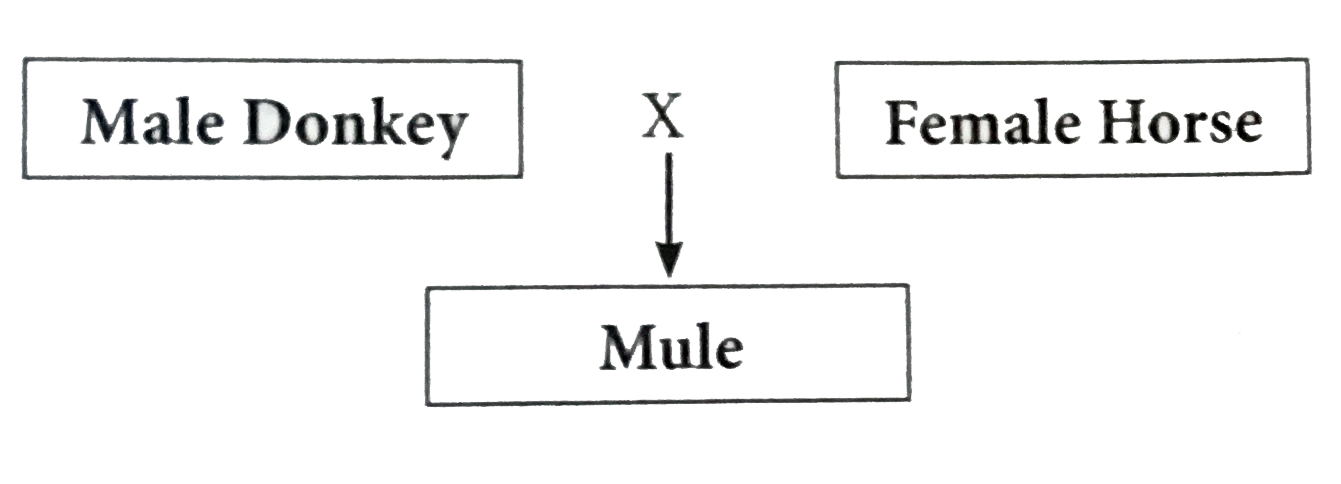
|
|
| 3672. |
Question : Differentiate between natural and artificial vegetative propagation in plants. |
Answer» SOLUTION :
|
|
| 3673. |
Question : Differentiate between mitosis and meiosis. |
Answer» SOLUTION :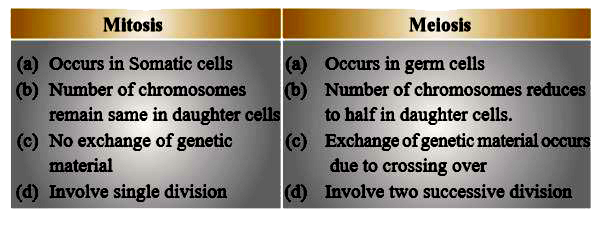
|
|
| 3674. |
Question : Differentiate between monoecious and dioecious plants. Give one example of each. |
|
Answer» Solution :Inherited CHARACTERS are PRESENT in the GENES and can be passed on to the DNA of the germ cells. Acquired TRAITS are experiences, CHANGE in non-reproductive tissues cannot be passed on to the DNA of the germ cells. |
|
| 3675. |
Question : Differentiate between fission of unicellular organism Leishmania and Plasmodium. |
Answer» SOLUTION :
|
|
| 3676. |
Question : Differentiate between chylomicron and micelles. |
Answer» SOLUTION :
|
|
| 3677. |
Question : Differentiate between chromatin and chromatid. |
|
Answer» SOLUTION :Chromatin Chromatid : (a) DIFFUSE, deep staining hereditary MATERIAL longitudinally split half of a chromosome, light staining hereditary material. (b) METABOLICALLY INERT Metabolically active. |
|
| 3678. |
Question : Differentiate between Caucasoid man and Mongoloid man based on their physical features. |
Answer» SOLUTION :
|
|
| 3679. |
Question : Differentiate between blood and lymph. |
Answer» SOLUTION :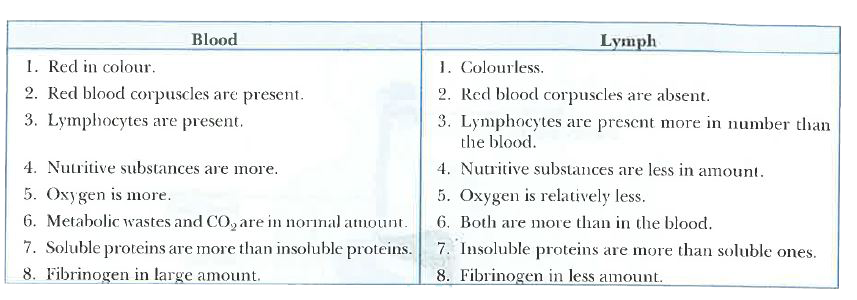
|
|
| 3680. |
Question : Differentiate between binary and multiple fission for reproduction. Give one example of each. |
Answer» SOLUTION :
|
|
| 3681. |
Question : Differentiate between autotrophs , heterotrophs and decomposers and give one example of each. |
Answer» SOLUTION :
|
|
| 3682. |
Question : Differentiate between arteries, veins and capillaries. |
Answer» SOLUTION :
|
|
| 3683. |
Question : Differentiate between aerobic and anaerobic respiration . |
| Answer» SOLUTION :`{:("Aerobic respiration","Anaerobic respiration"),("(1) A type of respiration that occurs in presence of oxygen.","(i) A type of respiration that occurs in absence of oxygen."),("(2) Complete oxidation of food TAKES PLACE.","(2) Incomplete oxidation of food takes place."),("(3) End-products are " CO_(2)","H_(2)O "and energy.","(3) End-products are " CO_(2) "lactic acid or alcohol and energy."),("(4) More amount of energy is released (36-38 ATP molecules).","(4) Less amount of energy is released (i.e.,2 ATP molecules)."),("(5) Itoccurs partly in cytoplasm,and partly in mitochondria.","(5) Itoccurs in cytoplasm."):}` | |
| 3684. |
Question : Give reasons. Diameter of afferent arteriole is bigger than efferent arteriole. |
Answer» SOLUTION :
|
|
| 3685. |
Question : Differentiate between a prokaryotic and eukaryotic cell. |
| Answer» SOLUTION :DIFFERENCE in nucleus/chromosome/mesosome/membrane BOUND CELL organells/ribosomes/compartments in cell. | |
| 3686. |
Question : Differentiate asexual and sexual reproduction. |
Answer» SOLUTION :Differences between ASEXUAL and Sexual forms of REPRODUCTION : 
|
|
| 3687. |
Question : 'Different species use different strategies to determine sex of a newborn individual. It can be environmental cues or genetically determined.' Explain the statement by giving example for each strategy. |
|
Answer» SOLUTION :Environmental Cue : (i) In some animals, the temperature at which fertilized eggs are kept DETERMINES whether the developing animal in egg is male or female. (II) In some animals like snail, INDIVIDUAL can change sex. Genetical Cue : A child who inherits an X-chromosome from the father will be a girl and one who inherits a Y-chromosome from the father will be boy. |
|
| 3688. |
Question : Different species use different strategies to determine sex of a newborn individual. It can be environmental cues or genetically determined.' Explain the statement by giving example for each strategy. |
| Answer» Solution :Different species use very different strategies for this. Some rely entirely on environmental cues. THUS, in some animals, the TEMPERATURE at which FERTILISED eggs are KEPT determines whether the animals developing in the eggs will be MALE or female. In other animals, such as snails, individuals can change sex, indicating that sex is not genetically determined. However, in human beings, the sex of the individual is largely genetically determined. In other words, the genes inherited from our parents decide whether we will be boys or girls. | |
| 3689. |
Question :'Different species use different strategies to determine sex of a newborn individual. It can be environmental cues or genetically determined'. Explain the statement by giving example for each strategy. |
|
Answer» Solution :Environmental cue: In some animals, the TEMPERATURE at which FERTILISED eggs are kept determines whether the developing animal in egg is male or female. In some animals like snail, individual can change SEX. GENETICAL cue: A child who inherits an X chromosome from the FATHER will be a girl and one who inherits a Y chromosome from the father will be a boy. |
|
| 3690. |
Question : Different organisms reproduce by different methods suitable to their body designs. (i) Justify the above statement using examples of two different organisms which reproduce by different methods of asexual reproduction, (ii) Differentiate between sexual and asexual modes of reproduction. |
|
Answer» Solution :(a) (i) Binary Fission in Amoeba-In this method, the nucleus first divides amitotically into two, followed by the division of the cytoplasm. The cell finally splits into two daughter cells. So, from one Amoeba parent, two daughter amoebae are formed. (II) Budding in Hydra-In Budding, a small part of the body of the parents grows out as a .bud which then detaches and BECOMES a new organism. Hydra REPRODUCES by budding USING the regenerative cells. A bud develops as an outgrowth in Hydra due to repeated cell division at one specific site. When fully mature, the bud detaches itself from the parent body and develops into new independent individuals. (iii) Regeneration in Planaria-In this method, small cut or broken PARTS of the organisms body grow or regenerate into separate individuals. Planaria can be cut into any number of picces and each piece grows into a complete organism. (b) Difference between jenxas and Asexual |
|
| 3691. |
Question : Dicot leaf is isobilateral leaf |
| Answer» Solution :FALSE- CORRECT STATEMENT: Monocot LEAF is a ISOBILATERAL leaf. | |
| 3692. |
Question : Diastema is associated with |
|
Answer» PRESENCE of CERTAIN teeth |
|
| 3693. |
Question : Diabetes insipidus is the syndrome which results due to the |
|
Answer» FAILURE of neurohypophysial system to inhibit the excess release of ADH |
|
| 3694. |
Question : What is triple fusion ? |
| Answer» SOLUTION :The fusion involving two polar nucleus and a sperm nucleus, that occurs in double FERTILIZATION in a seed plant and results in the FORMATION of ENDOSPERM, is called the TRIPLE fusion. | |
| 3695. |
Question : Determining Heart Rate: |
|
Answer» Solution :Materials :Stop WATCH or Stop clock. Procedure:1. Have your partner to find the pulse in your wrist and count your heartbeats for 15 seconds while you are seated. Calculate your RESTING heart rate in beats per minute. 2. Have your partner to count your heart beats for 15 seconds after you jog or run for 5 minutes. Calculate your heart rate in beats per minute. Analyse: • What causes your pulse ? Pulse, rhythmic dilation of an artery generated by the opening and closing of the aortic valve in the heart. A pulse can be felt by applying firm fingertip pressure to the skin at SITES where the arteries travel near the skin.s surface, it is more evident when SURROUNDING muscles are relaxed. • What causes the change in your heart beat rate in each SITUATION |
|
| 3696. |
Question : Design an experiment to demonstrate hydrotropism. |
|
Answer» Solution :Hydrotropism can be demonstrated with any germinating seedlings, which are allowed to grow on ground. The SOIL around the roots is separated by a polythene partition. The left side ia KEPT moist and the right side dry. The ridicle at first grows in a downward DIRECTION and after sometime the roots bend TOWARDS the moist soil. This is due to movement of the germinating roots to water. |
|
| 3697. |
Question : Desert can be converted into green land by |
|
Answer» HALOPHYTES |
|
| 3699. |
Question : Explain in the structure of spinal cord. |
|
Answer» Solution :Spinal CORD is a cylindrical structure lying in the neural canal of the vertebral column. It is also covered by meninges. It extends from the lower end of medulla oblongata to the first lumbar vertebra. The posterior most region of spinal cord tapers into a thin FIBROUS thread like structure called Filum terminale. INTERNALLY, the spinal cord contains a cerebrospinal FLUID filled cavity, known as the central canal. The grey matter of spinal cord is .H. shaped. The upper end of letter, .H. forms posterior horns and lower end forms anterior horns. A bundle of fibres pass into the posterior horn forming dorsal or afferent root. Fibres pass outward, from the anterior horn forming ventral or efferent root. These two roots, joins to form spinal nerves. The white matter is external and have bundle of nerve tracts. Spinal cord conducts SENSORY and motor impulses to and from the brain. It controls the reflex actions of the body. |
|
| 3700. |
Question : Describe with diagram : Human - male reproductive system |
|
Answer» Solution :The male reproductive system consists of two parts : (1) Part which produce the germ cell and (2) Part that delivers the germ cells to the site of fertilisation. Testes : 1 pair, located outside the abdominal cavity in scrotum. This is because sperm formation requires `2-3^(@)C` lower temperature than the normal body temperature `(37^(@)C)`. The formation of germ cells or sperms takes place in the testes. Testes secrete male sex hormone testosterone. In BOYS testosterone regulates the formation of sperms, and BRINGS about secondary sexual changes at the time of puberty.  Vas deferens : The sperms formed are delivered through these DUCTS unite with a tube coming from the urinary bladder. URETHRA : It is a common passage for the sperms and urine. Accessory glands : Along the path of the vas deferens, glands like prostate and the seminal vesicles add their secretions. This secretory fluid makes transport of sperms easier and also provides nutrition to the sperms for their motility. |
|